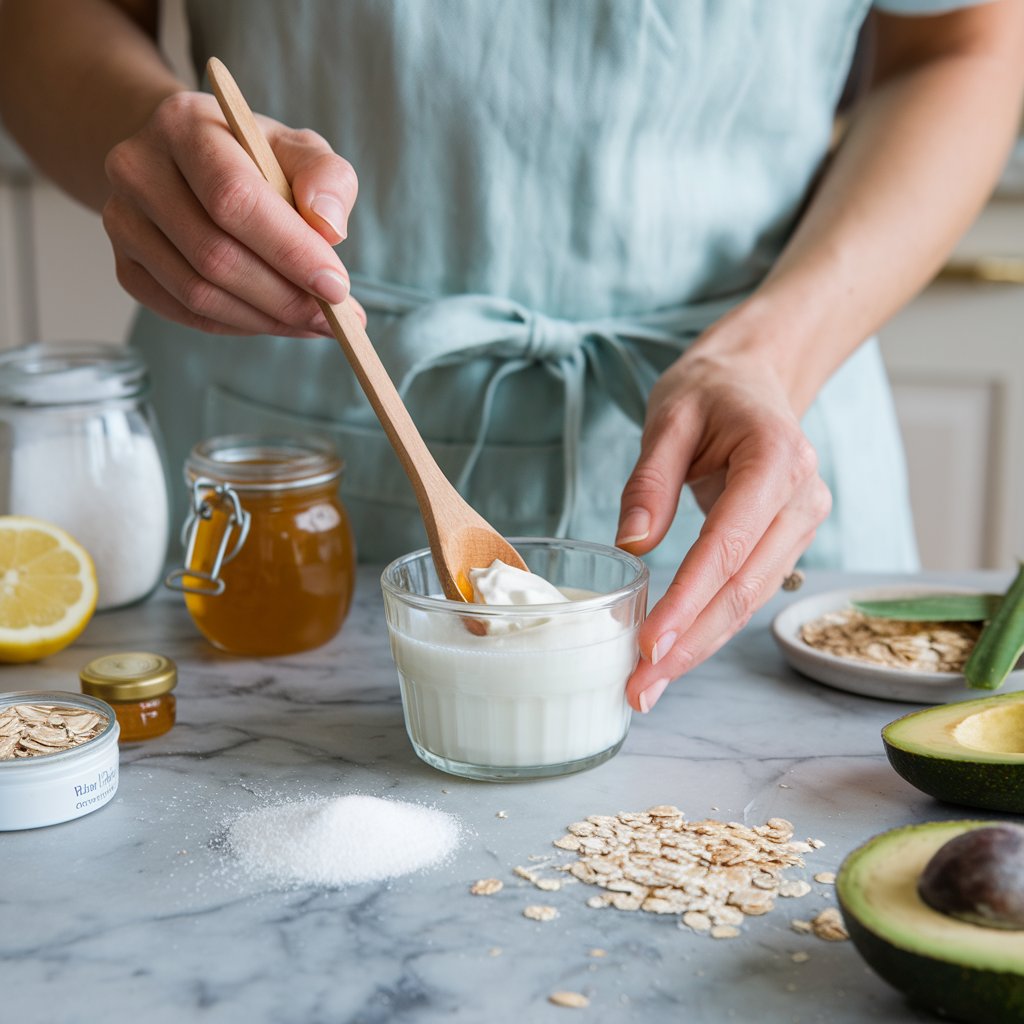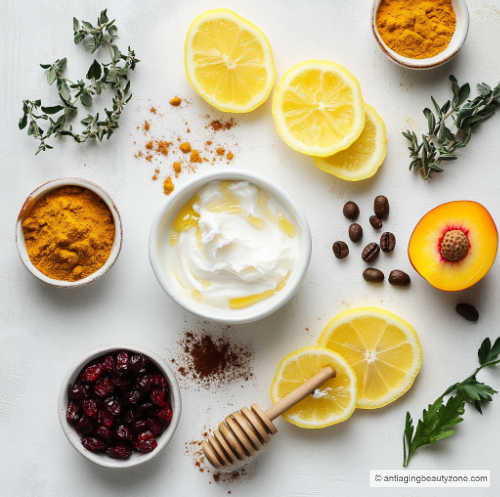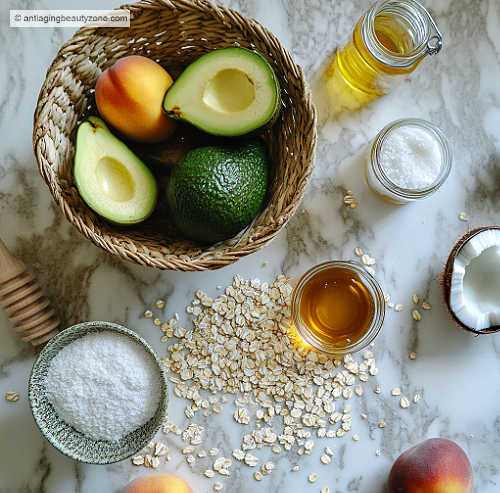As an Amazon Associate, I earn from qualifying purchases and other affiliate links. I only recommend products I’ve tried or researched.
- Home
- Skincare Guide
- Homemade Skincare
Homemade Skincare Recipes: Natural & Organic Beauty Hacks
Try these DIY face masks & face scrubs… for smooth, youthful skin
by: Linda Robison / Facial Fitness Specialist
Homemade skincare is fun, creative, and budget-friendly—and you control exactly what goes on your face.
I learned that from my grandmother, who mixed simple kitchen ingredients into remedies; her beautiful skin made me trust the basics and sparked my own skincare journey.

Why make your own skincare?
Whether you're mixing up face masks or facial scrubs, using natural ingredients like avocado, honey, or oats gives you full control over what you’re putting on your skin—no harsh chemicals, no overpriced gimmicks.
Plus, you’ll save money, reduce waste, and craft something that works for your unique skin type. It’s affordable, sustainable, and honestly... kinda fun.
Find your perfect scrub or mask
Tap a tile to explore recipes and results — each one tested on real skin, not just theory.
What are enzyme masks?
Enzyme masks are powerful!
I'm always surprised how using natural fruit enzymes (like papaya, pumpkin, or pineapple) can really loosen dead skin cells and make your face feels smoother and a little brighter—without using scratchy grains or a harsh peel.
If you want a full breakdown of how they work and why they’re so popular for mature skin, see my enzyme mask benefits and see DIY enzyme recipes.
Getting started: Kitchen staples
These basic ingredients are my go-tos when making anything from masks to scrubs and balms:
- Honey – hydrates and calms irritation
- Oats – soothes sensitive skin
- Yogurt – gently exfoliates with lactic acid
- Sugar – buffs away dead skin cells
- Almond oil – smooths and nourishes mature skin
- Coconut oil – locks in moisture
- Aloe vera – calms redness and hydrates
- Avocados – softens dry skin with healthy fats
- Shea butter – rich, thick moisture great for hands, elbows and heels too
These ingredients can be mixed and matched depending on what your skin needs.
DIY mask & scrub ideas
 From my kitchen to yours.
From my kitchen to yours.I’ve tested a ton—these are the keepers. I grouped them by skin goal so you can find what you need fast.
Exfoliation & Smoothness
Firmness & Glow
Brightening & Calm
- Turmeric scrub-mask
- DIY masks for oily/acne-prone skin
Note: Many scrubs can double as scrub-masks—apply, let sit 5–10 minutes, then massage lightly and rinse. Always patch-test first.
Quick-start skincare routine
- Cleanse: start with a gentle wash (over 40? see Best Cleansers 40+).
- Exfoliate: 1–2× weekly with a sugar scrub or an enzyme mask.
- Treat & moisturize: choose one DIY from the library above, then seal with a hydrator (see antioxidant moisturizers).
Easy DIY skincare recipes

Not ready to dive into pages? Here are a few simple combos to get started right now:
1. Soothing Oat Mask
1/2 cup oats + 1 tbsp honey + warm water
Apply and leave on for 15 minutes, then rinse.
2. Aloe Vera Glow Mask
2 tbsp aloe gel + 1 tsp honey + 1 vitamin E capsule
Apply, leave for 15–20 mins, rinse.
3. Shea Butter Moisturizer
2 tbsp shea butter + 1 tsp jojoba oil + 2 drops lavender oil
Whip into a fluffy balm and use on dry areas.
Choose organic options whenever possible to further boost their benefits for your skin. Plus: Organic farming practices are typically better for the environment.
How to store your mixes
To keep your DIY masks and scrubs fresh, safe, and ready to use, follow these quick storage tips below:
- Make small batches: no preservatives = shorter shelf life.
- Use clean, airtight jars: keep water out of the container.
- Oil-only scrubs (no water): good for up to 2 weeks at room temp; if smell or texture changes, remake.
- Honey/sugar scrubs (water can creep in): plan to use within 1 week.
- Fresh/wet masks (yogurt, fruit, aloe): mix right before use; refrigerate leftovers and use within 24–48 hours.
- Label it: add the date and ingredients.
- When in doubt, toss it: any odd odor, color change, or separation = make a new batch.
- Store-bought masks: follow the brand’s instructions and check expiration dates.
What's next?
- Face Mask Comparison Guide: Different mask types and when to use them.
- Natural Skin Tightening: Massage, tools, and routines that lift.
- Not sure if you’re using your masks the right way? Check out my Facial Mask Dos & Don’ts for common mistakes and how to fix them.
FAQs
Question: How long do homemade sugar scrubs last?
Question: How long do homemade sugar scrubs last?
Answer: If you keep water out, about 1 week. Oil-only versions can last up to 2 weeks.
Question: Can I refrigerate leftover DIY masks?
Question: Can I refrigerate leftover DIY masks?
Answer: Yes—for fresh/wet masks only. Keep covered and use within 24–48 hours.
Question: Can I freeze leftover face masks?
Question: Can I freeze leftover face masks?
Answer: Not ideal—textures separate. Better to mix small batches and use fresh.
Question: What’s the best container for DIY skincare?
Question: What’s the best container for DIY skincare?
Answer: Clean, airtight glass jars (amber/clear) with tight lids; label with date + ingredients.
Question: How do I know if my scrub or mask went bad?
Question: How do I know if my scrub or mask went bad?
Answer: Any odor, color change, separation, or mold = toss and remake.
Takeaway
You don’t need a drawer full of expensive products to have great skin. With a few kitchen staples—and maybe a little help from grandma’s wisdom—you can create skincare that’s nourishing, clean, and effective.
Try a recipe, see what works, and build your own glow-up routine right at home!
Want more easy, effective tips like these? Sign up for my newsletter and get my favorite at-home glow tricks, natural firming methods, and seasonal skincare updates—delivered straight to your inbox once a month. 💌
About the Author:
Linda Robison is a Facial Fitness Specialist and the founder of Anti-Aging Beauty Zone. With decades of hands-on experience, she shares practical, natural ways to lift and brighten mature skin—without expensive or invasive treatments.
Before you go ....
Please tap on the💙in the bottom right corner if you found this page helpful.
FOLLOW ME FOR MORE TIPS:
SHARE OR SAVE FOR LATER:












